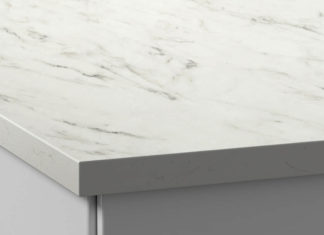How does one determine what wall cabinet height to choose from? One would typically assume that with an 8’ ceiling, they can fit 42” wall cabinets. There are two distinct factors that help one determine which size wall cabinets they will need. Those being the cabinet countertop clearance and the kitchen’s ceiling height.
Base cabinets with countertop will measure 36” tall (34.5” for the cabinet and 1.5” for the countertop). This cabinet height does not change as standard kitchen appliances are built and designed to this height. Not only that but kitchen outlets are also typically set at 43” from the bottom of the box to the floor. This puts it 7” from the kitchen countertop.
Countertop Clearance
Countertop clearance will typically measure 18” tall. This space is the most controversial as some people may prefer smaller clearance and more upper storage space. Below lists some common countertop appliances and the standard height they measure.
| Appliance | Height |
| Blender | 17.75” |
| Coffee maker | 12” |
| Rice Cooker | 10” |
| Stand Mixer | 17” |
| Slow Cooker | 14.5” |
| Air Fryer | 14” |
| Toaster | 10” |
| Microwave | 12-15” |
| Kettle | 9.5” |
| Toaster Oven | 10” |
| Pressure Cooker | 14.5” |
| Juicer | 16” |
Having a countertop clearance too high means accessing the wall cabinets will be very difficult. If one is heavily considering larger sized small appliances, the wall cabinets will need to be installed higher or smaller wall cabinets will be needed. The last thing someone needs is for their coffee maker to not fit in the designated space.
Wall cabinets based on ceiling height
With the base cabinets and the countertop clearance measuring 54” tall, the remaining wall will determine which cabinet height. With three different sizes of standard wall cabinets(30”, 36”. 42”), which option does one go with?
Kitchen ceiling heights are usually one of 3 options: 84”, 96”, or any unique ceilings larger than 96″.
 When considering countertop clearance and ceiling height, the remaining amount of space for wall cabinets should allow for some room to accommodate for wall imperfections. These can be solved by fillers, scribe, or crown molding.
When considering countertop clearance and ceiling height, the remaining amount of space for wall cabinets should allow for some room to accommodate for wall imperfections. These can be solved by fillers, scribe, or crown molding.84” ceilings are for trailer homes or 2 story homes that have a soffit in the kitchen. Soffits are a dropdown box from the natural ceiling that contains the water piping from the second floor. Depending on the architecture, some soffits can be removed during the remodeling process. If not, then kitchen wall cabinets will be lined up near the ceiling. These kitchens cannot afford to have crown molding installed. Rather, scribe molding is installed to fill minor gap imperfections from the top of the cabinet to the soffit. It is not advised to drop the cabinets lower as standard appliances may not fit underneath.
96” ceilings will use 36” tall cabinets. Although some may think they can use 42” wall cabinets as it adds up to exactly 96”, there would not be enough room for crown molding. Unless the ceiling is dropped like soffits do, most homeowners will want the crown molding to decorate the top of the cabinets. This option actually gives homeowners the flexibility to raise the countertop clearance a bit higher or use elevated molding. By installing filler underneath the diagonal crown molding, they can make the cabinets more exaggerated in design.
Kitchens with a ceiling height that are taller than 96” (typically 108” ceilings) will have the most flexibility. Homes with incredibly large ceilings may vary from unique architecture or much more open in design. These kitchens will commonly use 42” wall cabinets, as they are the tallest standard RTA cabinets available. Homeowners looking to go above and beyond can use double stack cabinets. A mix of 30” wall cabinets and 12” smaller cabinets on top can create an elegant design. Some may even choose to have these smaller cabinets to feature glass doors.





